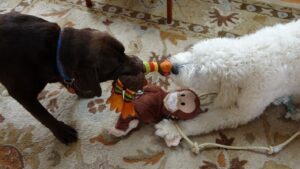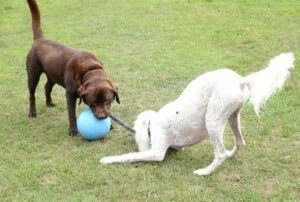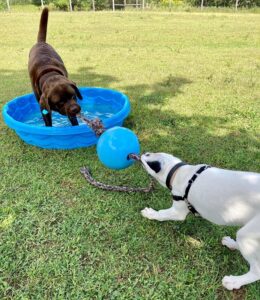Pets and Their People Blog
Should I Play Tug with My Puppy?
Should I play tug with my puppy? Yes, with only a few simple rules.
There are many myths in the world of dog training. One such myth is that playing tug with a dog encourages aggressive behavior. There is no evidence supporting that notion, so you can relax and play tug with your pup.

So, why are puppies so mouthy?
One common, if not universal, complaint I hear from puppy families is that their pups grab their clothing and tug.
Consider that everything in the puppy’s world is a new experience and since puppies have no thumbs, they explore with their mouths. A puppy might wonder, “Is this something I can eat, or play with?” When a puppy grabs our pant leg, sleeve, or hand, they are trying to interact with us in the only way they know how…and doing so always gains our attention so the behavior is reinforced.
For the first several weeks of life, the puppy was surrounded by littermates, and they played with one another, using their mouths to grab and pull on each other. I think it is natural if they should think that is also how to play with people.

When I work with a puppy, I always have one or two items within reach, so I can offer the puppy something more appropriate to grab and tug. It might be a small towel rolled up like a soft rope, a stuffed animal, or a commercial tug rope.
By giving a puppy an appropriate toy to tug with, we are saving our clothes from rips and tears by those sharp little teeth, and our tender skin as well. Plus, we are affording our puppy the opportunity to engage in very normal doggie behavior.
What are the tug rules?
- Safety for the puppy. When I hold the tug toy I may jiggle it around a bit, but not with much lateral (side to side) movement because I do not want to harm the puppy’s neck. That means I am not swinging the puppy around violently or taking the puppy off their feet. The puppy, on the other hand, is in control of their own movement and they may enjoy yanking the toy from side to side.
- Safety for the human. Another rule is that the puppy can grab the toy, but not the human. My Labrador, Jake, loved playing tug. I used a long enough rope that he could have one end, I had the other and there was plenty of room in the middle. Jake would tug a bit and then readjust his mouth closer to the middle, then again and again until he reached my hand. If his mouth touched my hand, I let go of the toy and quietly walked away. After pausing a short time, I returned to Jake and resumed the game, each of us taking an end of the toy. Refraining from grabbing my skin or clothing during tug was reinforced, so of course, Jake soon learned that keeping his mouth on the toy kept the game going, but putting his mouth on me made the game stop.
Bruno playing tug with his doggy friend, Fern. (Photo by Daniel Antolec) - The goal is to have fun together! My Labrador, Bruno (pictured), often brings a toy to me and initiates a tug game. He is 73 pounds and athletic, so we play more vigorously than I do with a puppy, but I often let go of the toy and declare “You won!” Then, Bruno happily offers the toy, and we play again. Sometimes I keep holding onto the toy and neither of us wins. It is fun either way, and that is how I have observed Bruno playing with his doggy friends. If you’re wondering, should the human always “win” so the puppy does not become “dominant,” you can relax and forget about this misinformation; there is no evidence to support it.
Dominance theory, the concept that dogs are always trying to take control from humans and dominate us, is another myth.
- When does the game end? At some point the game must end, so I use a cue as the off switch. When I think that Bruno is satisfied, I say, “That’s enough for now” in a cheery tone. You could put the toy away, or just go do something else and leave the toy available in case your dog wants to play by himself.
Tug is a good way to teach a dog to Take it & Leave It, as a counter to potential resource guarding. It is also good exercise and an outlet for the need to mouth and chew. You might even present the tug toy as a reward for another behavior you request of your puppy, in lieu of food treats.
So, go ahead, be creative, and enjoy playing with your pup!
About the Author
Daniel H. Antolec, PCT-A, CCBC-KA, CPDT-KA began teaching dogs in 2011 and founded Happy Buddha Dog Training. He teaches dogs in a way that makes it fun for pet stewards and pets alike.


